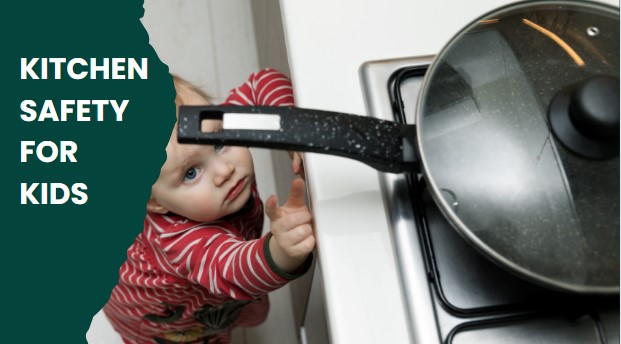1. Keep Your Work area Spotless and Coordinated
A cluttered kitchen can lead to chaos—and chaos can lead to accidents. When your workspace is messy, it’s easy to spill something, knock over a knife, or lose track of a hot pan.
Why it matters: A clean, organized kitchen lets you work efficiently. All the more critically, it diminishes the gamble of mishaps. Slippery floors from spills and sharp tools on countertops can cause injury.
Actionable Tips:
Clean up as you go. After chopping vegetables or mixing ingredients, clean the area before moving on. This helps prevent spills and gives you a clear view of what you’re working with.
Wipe up spills immediately: If something spills, clean it up right away to avoid slipping.
Organize your tools. Keep knives, spoons, and spatulas in their places. This way, you won’t be searching for them when you need them most. A tidy kitchen is a safe kitchen.
Knife Safety: Use Sharp Knives and Handle Them Properly
One of the most common kitchen injuries comes from improper use of knives. In all honesty, utilizing a dull blade is more perilous than utilizing a sharp one.
Why sharp knives are safer: A dull knife requires more pressure to cut This forms the potential outcomes slipping and cutting yourself. On the other hand, a sharp knife allows for more control and precision.
Actionable Tips:
Keep knives sharp: Regularly sharpen your knives to ensure they cut through food easily. You can utilize a honing stone or an electric blade sharpener.
Cut away from your body: Always cut away from your body to avoid the blade slipping toward your hand.
Use a stable cutting board: A cutting board that moves around is a recipe for disaster. Place a damp towel under your board to keep it steady.
Store knives properly: When not in use, store knives in a knife block or on a magnetic strip. Never leave loose knives in a drawer. They could cut someone reaching for another tool.
Be Cautious of Heat and Avoid Burns
Kitchens are full of hot surfaces, from stoves to ovens, to boiling pots of water. Being mindful of heat sources is critical to avoid painful burns.
Common heat hazards: Heat related accidents are frequent in the kitchen. They often result from touching a hot pan or getting too close to a burner.
Actionable Tips:
Use oven mitts or potholders. Always use thick, heat resistant mitts to handle hot pans, baking sheets, or oven racks. Thin towels won’t protect you from burns.
Turn pot handles inward: When cooking on the stove, turn pot handles inward so they don’t stick out. This prevents you from accidentally bumping into them and spilling hot food.
Beware of steam burns: Steam can cause serious burns, often without much warning. Always open pot lids away from you to let the steam escape safely.
Food Safety: Avoid Cross Contamination
Preventing foodborne illness is just as important as avoiding physical injuries. Raw meat, poultry, and seafood can harbor harmful bacteria that can spread if you’re not careful.
Why it matters: Cross contamination can cause food poisoning. It can prompt serious medical problems.
Actionable Tips:
Use separate cutting boards. One for raw meats, another for vegetables, fruits, and cooked foods. This prevents bacteria from spreading.
Wash your hands often. After handling raw meat, eggs, or seafood, use soap and water before touching other foods.
Refrigerate leftovers quickly: Don’t leave cooked food sitting out for more than two hours. Bacteria can grow quickly at room temperature. So, store leftovers in airtight containers and refrigerate them promptly.
Use Electrical Appliances Safely
Blenders, mixers, and other electric appliances are kitchen essentials. Yet, they can be hazardous in the event that not utilized as expected.
Common hazards: Frayed wires, overloaded outlets, and improper appliance use can cause electric shock or fire.
Actionable Tips:
Inspect cords regularly: Check your appliances for frayed or damaged cords. If you see any wear and tear, repair or replace the appliance immediately.
Don’t overload outlets: Plugging too many appliances into one outlet can cause overheating and increase the risk of an electrical fire. Use different outlets for different appliances.
Unplug appliances when not in use: After you’re finished using an appliance, unplug it to reduce the risk of accidental shocks or fires.
Stay Alert and Focused While Cooking
It’s easy to get distracted while cooking, especially if you’re multitasking or have people around. However, losing focus even for a moment can lead to accidents.
Why it matters: An unattended stove or a distraction while chopping vegetables can quickly turn dangerous
Actionable Tips:
Never leave cooking unattended: If you need to leave the kitchen, turn off the stove or ask someone to watch it for you. Fires can start in an instant, especially when frying or grilling.
Take breaks if needed: Cooking can be tiring, so make sure you stay hydrated and take short breaks if necessary. Fatigue can make you more prone to mistakes.
Limit distractions: Music or podcasts can make cooking more fun. But, avoid getting too distracted by screens or conversations
Be Prepared for Kitchen Fires
Kitchen fires can be terrifying, but knowing how to handle them can prevent a small flare up from becoming a major disaster.
Common fire hazards: Grease fires, electrical fires, and oven mishaps are some of the most common causes of kitchen fires.
Actionable Tips:
Keep a fire extinguisher nearby: Make sure it’s easily accessible and that everyone in the household knows how to use it.
Handle grease fires carefully: If a grease fire starts, never pour water on it—that will make the fire worse. Instead, smother the fire with a lid or use baking soda to extinguish the flames.
Know when to evacuate: If a fire gets out of control, evacuate immediately and call 911. It’s not worth risking your safety to try and put out a fire yourself.
Protect Children and Pets in the Kitchen
Children and pets are curious by nature, and the kitchen can be a dangerous place for them.
Why it matters: Hot stoves, sharp knives, and heavy pots are all potential hazards for kids and pets
Actionable Tips:
Create a “kid free zone”: Teach children to stay away from the stove and hot surfaces. Set boundaries to keep them out of harm’s way.
Keep sharp tools and hot items out of reach. Store knives, heavy pots, and other dangerous items in high cabinets or drawers.
Watch out for pets underfoot. They can get underfoot while you cook. This increases the risk of tripping or dropping something hot on them.
Dress for Kitchen Safety
What you wear in the kitchen can also affect your safety. Loose clothing or long hair can easily catch fire or get caught in kitchen equipment.
Why it matters: Long sleeves, scarves, and dangling jewelry can be dangerous around open flames or sharp tools.
Actionable Tips:
Wear fitted clothing: Choose clothes that fit snugly, or roll up long sleeves. This prevents them from getting caught or catching fire.
Tie back long hair: Long hair should be pulled back into a bun or ponytail to keep it out of your way.
Avoid dangling jewelry. Remove any rings, bracelets, or necklaces. They could get caught on kitchen equipment.
Conclusion
Security ought to continuously be fundamentally important in the kitchen. To reduce accidents, follow these tips: Keep your space clean. Handle knives carefully. Stay alert. Be cautious with heat, food, and appliances. Cooking can be fun. But, safety lets you focus on what matters: making delicious meals for your loved ones.
Call to Action: What safety measures do you use in your kitchen? Share your tips in the comments below, and don’t forget to share this post to help others keep their kitchen safe!


is a digital marketing consultant with a passion for advanced living, is the man behind this blog, where he shares his love for all things kitchen and culinary trends to help you elevate your cooking experience.



